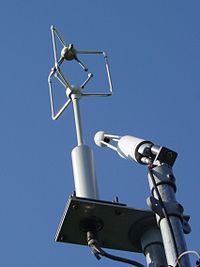
The eddy covariance (also known as eddy correlation and eddy flux) is a key atmospheric measurement technique to measure and calculate vertical turbulent fluxes within atmospheric boundary layers. The method analyses high-frequency wind and scalar atmospheric data series, gas, energy, and momentum,[1] which yields values of fluxes of these properties. It is a statistical method used in meteorology and other applications (micrometeorology, oceanography, hydrology, agricultural sciences, industrial and regulatory applications, etc.) to determine exchange rates of trace gases over natural ecosystems and agricultural fields, and to quantify gas emissions rates from other land and water areas. It is frequently used to estimate momentum, heat, water vapour, carbon dioxide and methane fluxes.[2][3][4][5][6][7]
The technique is also used extensively for verification and tuning of global climate models, mesoscale and weather models, complex biogeochemical and ecological models, and remote sensing estimates from satellites and aircraft. The technique is mathematically complex, and requires significant care in setting up and processing data. To date,[when?] there is no uniform terminology or a single methodology for the eddy covariance technique, but much effort is being made by flux measurement networks (e.g., FluxNet, Ameriflux, ICOS, CarboEurope, Fluxnet Canada, OzFlux, NEON, and iLEAPS) to unify the various approaches.

The technique has additionally proven applicable under water to the benthic zone for measuring oxygen fluxes between the sea floor and overlying water.[8] In these environments, the technique is generally known as the eddy correlation technique, or just eddy correlation. Oxygen fluxes are extracted from raw measurements largely following the same principles as used in the atmosphere, and they are typically used as a proxy for carbon exchange, which is important for local and global carbon budgets. For most benthic ecosystems, eddy correlation is the most accurate technique for measuring in-situ fluxes. The technique's development and its applications under water remains a fruitful area of research.[9][10][11][12][13]
- ^ Liang, Shunlin; Li, Xiaowen; Wang, Jindi, eds. (2012-01-01), "Chapter 16 - Vegetation Production in Terrestrial Ecosystems", Advanced Remote Sensing, Academic Press, pp. 501–531, doi:10.1016/b978-0-12-385954-9.00016-2, ISBN 978-0-12-385954-9, retrieved 2020-03-12
- ^ Baldocchi, D., B. Hicks, and T. Meyers. 1988. Measuring biosphere-atmosphere exchanges of biologically related gases with micrometeorological methods. Ecology 69, 1331-1340
- ^ Verma, S.B.: 1990, Micrometeorological methods for measuring surface fluxes of mass and energy, Remote Sensing Reviews 5(1): 99-115
- ^ Lee, X., W. Massman, and B. Law. 2004. Handbook of Micrometeorology. Kluwer Academic Publishers, The Netherlands, 250 pp.
- ^ Burba, G., 2013. Eddy Covariance Method for Scientific, Industrial, Agricultural and Regulatory Applications: a Field Book on Measuring Ecosystem Gas Exchange and Areal Emission Rates. LI-COR Biosciences, Lincoln, USA, 331 pp.
- ^ Aubinet, M., T. Vesala, D. Papale (Eds.), 2012. Eddy Covariance: A Practical Guide to Measurement and Data Analysis. Springer Atmospheric Sciences, Springer Verlag, 438 pp.
- ^ Burba, George (2022-09-06). Eddy Covariance Method For Scientific, Regulatory, and Commercial Applications. LI-COR Biosciences. ISBN 978-0-578-97714-0.
- ^ Berg, P., H. Røy, F. Janssen, V. Meyer, B. B. Jørgensen, M. Hüttel, and D. de Beer. 2003. Oxygen uptake by aquatic sediments measured with a novel non-invasive eddy correlation technique. Marine Ecology Progress Series. 261:75-83.
- ^ University of Virginia. Aquatic Eddy Covariance Research Lab. Retrieved: 22 June 2015.
- ^ The Florida State University. Eddy Correlation - Further Development and Studies of Flow and Light driven dynamics of Benthic Oxygen Exchange Archived 2014-04-18 at the Wayback Machine. Retrieved: 22 June 2015.
- ^ Leibniz-Institute of Freshwater Ecology and Inland Fisheries. Eddy Correlation in Natural Waters. Retrieved: 22 June 2015.
- ^ Max Planck Institute for Marine Microbiology. Eddy Correlation System (ECS). Retrieved: 22 June 2015.
- ^ Centre for Coastal Biogeochemistry Research. Eddy Correlation Archived 2013-12-13 at the Wayback Machine. Retrieved: 22 June 2015.